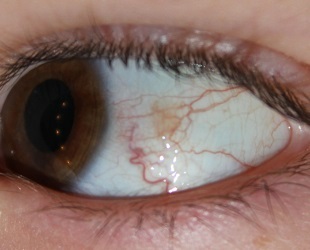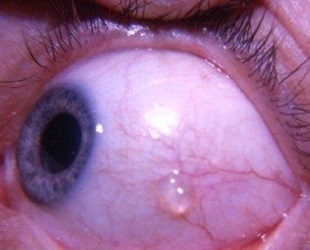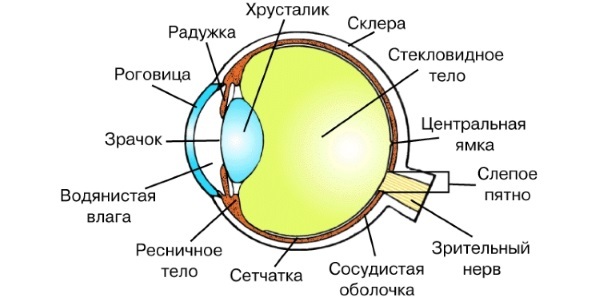
On the eye for various reasons, many painful lesions may appear.
And to a different extent they do not deliver convenience, and sometimes significantly affect the eyesight and overall well-being.
Among benign inflammations can be identified cyst. This is a small, transparent, rounded formation filled with fluid or epithelial tissues.
It can occur both on the cornea and on the eyelid. Let's take a look at the cyst further in the article
- 1. Symptoms and varieties
- 2. Causes of occurrence of
- 3. Diagnosis and treatment of
- 4. Prevention of
- 5. Conclusion
- 6. Video
Symptoms and varieties
For all types of diseasecharacterized by the presence of a round sack on the surface of the eye. Most often this manifests itself on the cornea and is localized in its extreme regions.
In rare cases, the occurrence of a cyst in the inner regions( located between the eyelid and the cornea) of the lower and upper eyelids is possible.
The content and appearance of such bags may vary and depends on the type of cyst. The following varieties are distinguished:
| Cyst type | Appearance |
| Pearl | Is a bluish white formation that is distinguished by dense walls and opacity |
| Serous | Transparent and filled with liquid. This type of cyst is most often manifested in humans. Tends to increase in size, which can lead to edema of the eye |
| Epithelial | Small, flat translucent formations, have a brown color. They consist of epithelial tissues: skin, hair, nails. These tissues enter the eye chamber during the embryonic period |
| Stromal | The most rare form of the disease. It differs from epithelial formations with greater transparency and unpredictability of its development: it is possible both for the complete disappearance of the cyst and for its rapid increase in size. Its location in the eye chamber is unstable, over time it can move to different areas. Arises in the first year of life |
Health impact

The effect of a cyst on a person's well-being can range from complete painlessness to creating significant vision problems.
Painless for a person, usually an epithelial cyst: it does not increase in size, does not reduce visual acuity, does not cover its angles.
Serous and stromal cysts, increasing in size, can increase intraocular pressure and provoke the development of glaucoma, reduce the angles of vision, seriously worsen the appearance of a person.
They also correspond to unpleasant feelings of squeezing in the eyes, which increase when they are closed( especially when blinking), black spots and other foreign objects may appear before the eyes.
In the long term, such manifestations lead to deformation of the eyeball and a decrease in visual acuity due to the displacement of the lens.
Causes of
The cyst can be congenital and acquired. The congenital cyst appears due to abnormalities in the course of pregnancy or due to genetic pathologies.
The main pathology that provokes a congenital cyst is the separation of the iris, in which the structure of the ocular membrane is disturbed.
Acquired cyst is divided into traumatic, spontaneous and exudative.
Traumatic cyst occurs against the background of strong mechanical effects on the eyes and is manifested by pearly and serous formations. These include:
- Contact with foreign objects.
- Stay in the eye chamber of parasites.
- Transfer of inflammatory infectious diseases( conjunctivitis, scleritis).
- Taking some medications.
- The unsuccessful course of the recovery period after surgery, the occurrence of their complications.

Traumatic effects make the ocular membrane vulnerable, it absorbs excess fluid and particles of the epidermis, which leads to the development of the cyst. A traumatic cyst can also occur in the inner parts of the eyelids.
The causes of spontaneous cysts have not been precisely elucidated until now. As a rule, these formations do not develop to large sizes and arise at any age.
They can last only a few hours, and can annoy for days and weeks. It is statistically established that most often the spontaneous cyst occurs in children.
An exudative cyst is one of the possible complications of glaucoma. The increase in intraocular pressure, characteristic of this disease, provokes squeezing of the ocular membrane and a violation of the internal circulation of the fluid, which leads to the appearance of benign sack-like formations.
The exudative cyst is round in shape and dark in color. Most often it occurs near the pupil, because of this, it can be dangerous for the eyesight with its further development. Preparations from the group of anticholinesterases can also provoke the appearance of these formations.
Diagnosis and treatment of

The cyst is easily detected and differs from other inflammatory formations during an ophthalmologic examination.
Difficulties can arise only in the diagnosis of early stages of exudative and epithelial cysts due to their small size and insignificant discharge above the plane of the ocular membrane.
Treatment depends on the established form of education. There are two directions: medicamentous and surgical.
Medical therapy is effective in case of a traumatic cyst of small severity. In this case, drugs are prescribed that eliminate traumatic factors( anti-inflammatory drugs, antibiotics, corticosteroids), when they are eliminated, the cyst disappears on its own.
For the treatment of exudative cysts, it is enough to stop the symptoms of glaucoma and to cancel the use of anticholinesterases, after which the formation will gradually disappear itself.
Cysts of other varieties require surgical intervention. The most simple surgical method of is puncture, in which the cyst is pierced under general anesthesia, and the contents are sucked out of it.
Currently, the method is considered ineffective, such rough procedures can not provide a full and safe treatment of tender eye tissues, the risk of recurrences and complications is high.

After the puncture, a very long recovery period lasting up to several weeks is required.
The laser method replaced the punctures. The laser, being a high-precision instrument, allows to process the cyst walls along its entire perimeter, without affecting healthy tissues.
Complete restoration of the ocular membrane occurs in a few days, the chance of recurrence is minimal. The laser method is suitable for treating virtually all varieties of cyst.
But its price exceeds the cost of standard puncture operations.
Prevention
To prevent the development of a congenital cyst in a child, a pregnant mother should carefully monitor her health, she should not allow damage to the fetus and the use of potent drugs.
Prevention of a traumatic cyst implies avoidance of traumatic effects. Sometimes education can occur even because of the ingress of a small foreign body, so it is worthwhile to protect your eyes and monitor their hygiene.
When infectious and parasitic diseases are affected, to avoid complications, do not delay treatment.
To avoid the emergence of an exudative cyst, you need to carefully monitor the symptoms of glaucoma and in time to stop its significant manifestations.
Conclusion
The cyst is a benign formation on the ocular membrane or on the eyelids, which is provoked by a variety of reasons.
It can be congenital and acquired. The congenital cyst is caused by an irregular course of pregnancy and the separation of the iris. Acquired cyst is caused by traumatic effects and complications of glaucoma.
You can also select a spontaneous cyst, the exact causes of which are not established. The most effective way to eliminate such formations is the laser method.
Video
We bring to your attention the following video:
